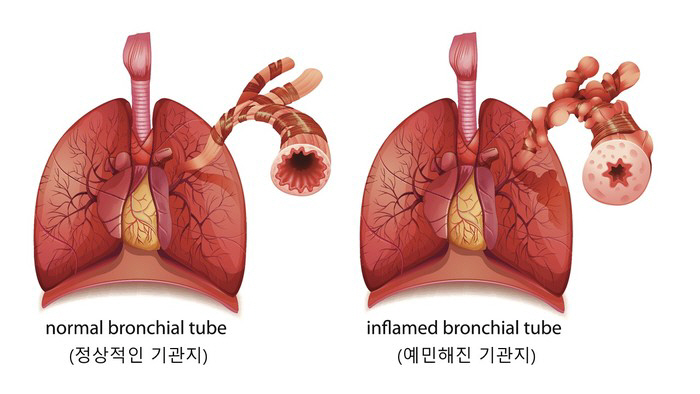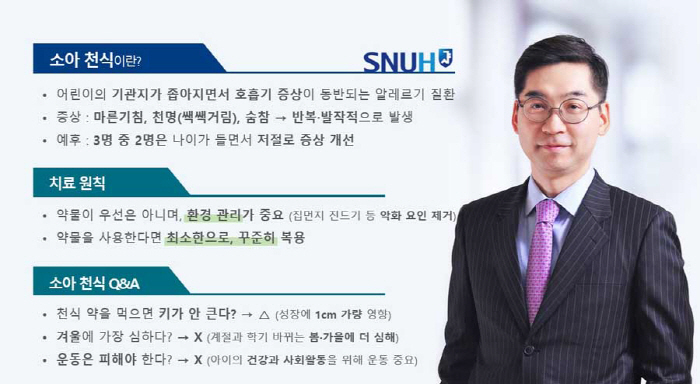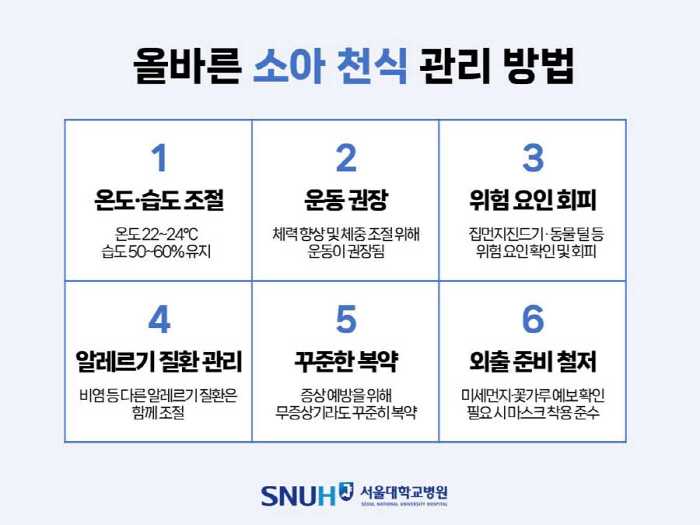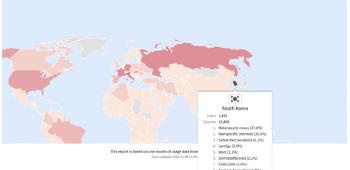Life threatening when having an acute asthma attack...How does your height grow when you take medicine?
May 07, 2025
|
However, if not treated properly, lung function is permanently reduced, and in severe cases, childhood asthma that can cause acute seizures and be life-threatening. From the treatment and management method to frequently asked questions, I looked into it through Q&A with Professor Seo Dong-in of the Department of Pediatrics and Adolescents at Seoul National University Hospital.
- What is childhood asthma?
▶Child asthma is a disease accompanied by various respiratory symptoms as the bronchial tubes in children's lungs become sensitive and narrow. It is known to occur mainly in the early stages of life.
Personal factors related to the outbreak are family history and the presence or absence of allergic diseases (atopy, allergic rhinitis), and environmental factors include air pollution, stress, and viral infection.
- What are the main symptoms?
▶ Symptoms of childhood asthma are dry cough, wheezing, breathlessness, and difficulty breathing during active activity. Unlike adults, pediatric asthma patients also complain of bocham, drooping, and vomiting.
A dangerous symptom in childhood asthma is an acute asthma attack in which the cough becomes paroxysmal. This is a life-threatening emergency that leads to hypoxia and respiratory failure and tends to worsen mainly at night time. As a result, symptom relief drugs are prescribed to cope at home, and if it doesn't work, you should visit the emergency room even late at night.
- What is the diagnosis?
▶The pediatric asthma test method is to check for cough or decreased saturation after using chemicals that narrow the bronchial tubes. In addition, it also checks whether specific symptoms of asthma (such as wheezing, shortness of breath, etc.) are present. Allergic tests are not essential for confirming asthma and are mainly conducted to find exacerbating factors. On the other hand, it is difficult to confirm children under the age of five, so it comprehensively determines whether specific symptoms are present and whether symptoms improve when taking asthma drugs for more than a month.
- What about environmental management?
▶The first step in treating childhood asthma is environmental management. The basis of asthma treatment is to use drugs when symptoms are not controlled, avoiding environments or substances that worsen symptoms. To do this, it is necessary to know the causative allergic substances.
In the case of house dust mite allergies, it is recommended to remove carpets that accumulate a lot of dust and use air purifiers and special duvet covers. However, it is unnecessary to purchase excessively expensive products. To cope with pollen and fine dust, outdoor activities should be minimized and protective equipment such as masks should be worn. It is important to check the real-time flowerpot index and fine dust forecast before going out, and to change clothes and wash well when you return from going out.
Indoor temperature and humidity management are also necessary. Cold dry air is a major exacerbator of asthma. It is recommended to create a slightly humid and warm environment with a temperature of 22~24℃ and a humidity of 50~60%, and to avoid activities that make breathing difficult. However, in warm environments, house dust mites grow well, so proper temperature and humidity should be maintained.
- What about the treatment?
▶Two types of drugs are used to treat childhood asthma: modulators and palliatives. Controllers are used to prevent symptoms, and palliatives are used to quickly improve worsening symptoms. However, there is a risk of side effects, so it is a principle to minimize drug use.
In principle, an inhaler is recommended for the medication administration method. However, only about 1 in 10 patients use the inhaler steadily. The rest are used intermittently, replaced with medication to eat, or no medication at all. In order to reduce bronchial inflammation and control asthma symptoms, efforts should be made to practice a steady medication habit even in normal times without symptoms. Patch-type bronchodilators are also prescribed to children who refuse the drug. This is less effective than the inhaler. If the patch falls off easily, a Band-Aid can be added on top of the patch to maintain attachment for a long time.
Immunotherapy is frequently recommended for pediatric allergic rhinitis patients, whereas it is not recommended as primary treatment for pediatric asthma patients. There is a risk that exposure to the causative agent temporarily worsens symptoms, so special attention is required for patients with severe asthma. In particular, the younger the patient is, the more immature he or she is to express symptoms, making it easier to overlook the side effects of immune drugs.
Professor Seo Dong-in said "Adult asthma requires lifelong treatment, while two out of three children's asthma patients have symptoms that disappear or improve in adulthood. The more severe the asthma symptoms, the less likely they are to heal, but I have seen many children outpatient who eventually got better after suffering. In asthma treatment, it is important to find and manage risk factors as well as drugs, so constant drug treatment and environmental management should be combined to help the child get better" he advised.
※The myth and truth of childhood asthma
◇If you take asthma medicine, you won't grow tall? (△)
Steroids that control bronchial inflammation may affect growth as a side effect. Therefore, inhalation steroids with less side effects are mainly used, and according to the study, the effect of inhalation steroids on the final height is insignificant, with an average of 1.1 cm. Some studies show that poorly treated asthma has a greater adverse effect on growth.
◇Asthetic symptoms are most severe in winter? (X)
Asthma symptoms are more likely to worsen in cold and dry winters than in summer, especially in spring and autumn. This is because they are vulnerable to colds or respiratory diseases during the change of seasons when the daily temperature range is large, and the risk of asthma worsening increases when the semester changes and encounters a new environment.
◇Should I avoid exercising? (X)
Exercise is recommended for children with asthma. In adult patients, it is recommended to avoid exercise because it can cause breathing difficulties. On the other hand, exercise is an important social activity for children, and maintaining physical strength and health through exercise also helps with treatment. In addition, there are no studies showing that dieting improves asthma, but there are many pediatric asthma patients who say 'Breathing has become easier after weight loss'.
|
|
This article was translated by Naver AI translator.
















